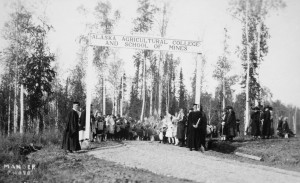Morrill Act public open house
April 9, 2012
907-474-5042
4/9/12
A federal act passed in 1862 affected the education of the U.S. population more than anything in history, but its name is not a household word. This July around the nation, that might change just a bit when the 150th anniversary of the Morrill Act is celebrated.
The University of Alaska Fairbanks is getting a jump on the party by designating April 15-21 to commemorate the Morrill Act with a bevy of events culminating in a public open house at the Wood Center on April 21 from noon to 4 p.m.

So what is the Morrill Act and why does UAF care? The act allowed land grant institutions for higher education to be established in every state, and UAF is Alaska’s land-grant university. Simply put, the act provided states with land to support institutions for the education of agriculture, military tactics and the mechanic arts.
“It’s a great thing,” UAF history professor Terrence Cole said. “It’s amazing how the land grant colleges vastly expanded higher education for citizens. It revolutionized American higher education.”
Before the Morrill Act, colleges focused on the liberal arts and classical studies of Latin and Greek. This Medieval model, as Cole called it, was all the country had until the 1860s. “At the time, people thought the summit of intellectual achievement was to learn Latin and Greek,” Cole said.
Until the Morrill Act, most colleges had a sectarian affiliation. “The act created a new branch of education that would involve the liberal arts but also agriculture and mechanical arts,” Cole said. In the 1860s the U.S. was overwhelmingly an agricultural country, hence the focus on agriculture at land grant institutions, he explained.
Cole, who will give a lecture on this topic April 16 at 7 p.m. on the UAF campus, practically jumped with excitement when he said, “This was giant! This was the first federal funding of higher education in America, and it was done through land.”
While the act was passed in 1862 it would be 1915 before an institution of higher education would be conceived of in Fairbanks. Alaska’s delegate to Congress, James Wickersham, advocated for approval of a land grant for an Alaska college and Alaska Territorial Gov. John Strong signed the bill in 1917 to establish and pay for Alaska’s land grant institution. By 1922, Fairbanks was home to the Agricultural College and School of Mines, known today as UAF.

Pointing out how Alaska is different from the other 49 states with land grant institutions, Cole calls UAF “the land grant college without much land.” Alaska never got all the land it was intended to have because back then the land hadn’t been surveyed.
The land Alaska received was initially called the Tanana Valley Land Grant and the acreage came to 9,000 instead of the intended 250,000 that had been authorized.
“Instead the state became responsible for financial support of the university in other ways,” Cole said. Would Alaska have a university if not for the land grant? “We’d probably have some sort of university but it wouldn’t have higher education at the level and quality we have,” he said. He also noted that prior to the establishment of what is now UAF, Alaska had the Alaska Methodist University, a private, liberal arts school in Anchorage (now named Alaska Pacific University).
“The university has been a fantastic institution for the people of Alaska,” Cole said. “It has helped develop the state, keep people here and enrich the cultural life of the community. All that goes back to the land grant.”
The Fairbanks Experiment Farm was established in 1906, so it made sense for the new college to be located nearby. “The college was created around the farm,” Cole said. “The university is here because of the farm.”
As for the land grant in general, Cole lamented the fact that most people don’t understand it or care about it, but he believes it made sweeping changes in this country. “People don’t realize how amazing it is,” he said. “We assume now that everyone has the opportunity to go to college if they want to.”
Find out about the schedule of events for the Morrill Act celebration.
This column is provided as a service by the UAF School of Natural Resources and Agricultural Sciences and the Agricultural and Forestry Experiment Station.


